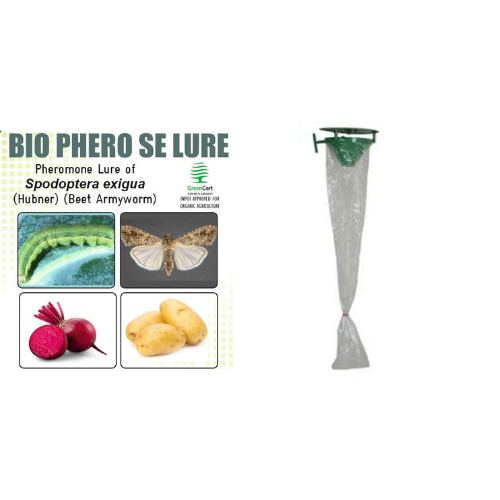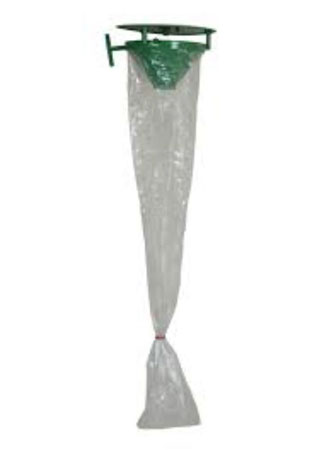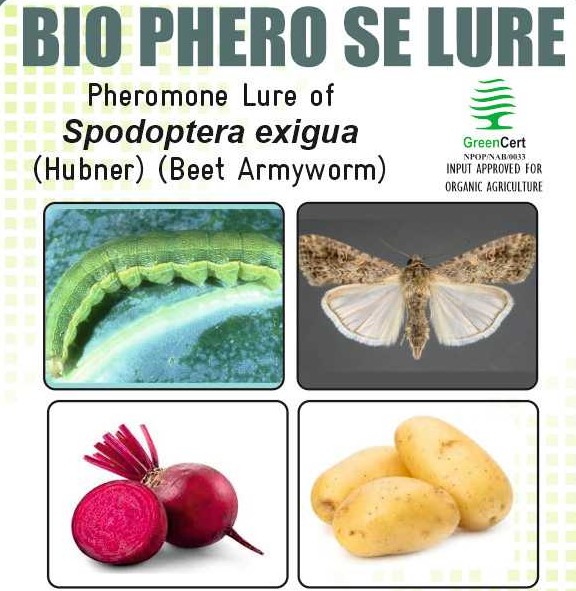




SONKUL AGRO INDUSTRIES PRIVATE LIMITED
Lure With Trap
Pheromone lure for Beet Armyworm (Spodoptera exigua).
Control Beet armyworm with BIO PHERO SE LURE.
Target crops: Beetroot, Tobacco, Sunflower, Potato, Peas, Beetroot, Sorghum, Castor, Maize, Jute, Groundnut, Broccoli, Cabbage, Cauliflower, Celery, Chickpea, Corn, Cowpea, Brinjal, Lettuce, Onion, Radish, Spinach, Sweet potato, Turnip, Capsicum / Chilli etc.
Usage Instruction-
-Cut opens this pack and slides the lure piece outside.
-Do not touch the lure with bare hands.
-Fix this lure properly in a trap by sliding it into the hole provided in the funnel trap.
-Replace the lure at the recommended duration.
-Wash hands thoroughly before and after handling the trap and lure.
-Discard used lure by burning or burying underground.
-Trap to be used: Funnel Trap
-No. of trap /acre: 7 - 8
-Life of Lure: 60 Days
Contents:
Pheromone lure of Spodoptera exigua (Beet Armyworm)
Identification-
Egg masses appear golden brown. Eggs are round, white and covered with small hairs.
Larvae are pale greenish with dark markings. Larvae are gregarious in the early stages.
Pupa is brown and 1.9 cm long. Forewings are brown in colour with wavy white markings. Hind wing white in colour with a brown patch along the margin
Life cycle Egg:
Eggs are laid in clusters of 50 to 150 eggs per mass. Normal egg production is about 300 to 600 per female.
Eggs are usually deposited on the lower surface of the leaf, and often near blossoms and the tip of the branch.
The individual eggs are circular when viewed from above, but when examined from the side the egg is slightly peaked, tapering to a point.
The eggs are greenish to white in colour and covered with a layer of whitish scales that gives the egg mass a fuzzy or cottony appearance.
Eggs hatch in two to three days during warm weather.
Larva: There normally are five instars.
The larvae are pale green or yellow in colour during the first and second instars but acquire pale stripes during the third instars.
During the fourth instar, larvae are darker dorsally and possess a dark lateral stripe.
Larvae during the fifth instars are quite variable in appearance, tending to be green dorsally with pink or yellow colour ventrally and a white stripe laterally.
A series of dark spots or dashes are often present dorsally and dorsolaterally.
Sometimes larvae are very dark in colour, even black.
The spiracles are white with a narrow black border. Pupa: Pupation occurs in the soil.
The chamber is constructed from sand and soil particles held together with an oral secretion that hardens when it dries.
The pupa is light brown in colour and measures about 15 to 20 mm in length.
The duration of the pupal stage is six to seven days during warm weather.
Adult:
The moths are moderately sized, the wing span measuring 25 to 30 mm.
The forewings are mottled grey and brown, and normally with an irregular banding pattern and a light colour bean-shaped spot.
The hind wings are a more uniform grey or white colour and trimmed with a dark line at the margin.
Mating occurs soon after the emergence of the moths, and oviposition begins within two to three days.
Oviposition extends over a three to seven-day period, and the moths usually perish within 9 to 10 days of emergence.
Nature of damage-
The beet armyworm (Spodoptera exigua) is one of the most destructive polyphagous pests.
Young beet armyworm larvae feed on the under-surface of leaves.
Fully-grown larvae devour foliage completely, leaving only major veins.
Newly hatched larvae are gregarious and migratory skeletonises.
The larvae feed on the tender leaves.
They scrape out the green matter in the leaf leaving the epidermis alone.
The second and third instar larvae feed by making small holes, late instars feed on the entire lamina, petiole, and even the twigs on the terminal shoots of plants. Later, the larvae spread in the field causing defoliation.
The larvae also feed on the developing pods. During the fruiting stage, the larva scrapes the pods and feeds on it.
Target crops: Beetroot, Tobacco, Sunflower, Potato, Peas, Beetroot, Sorghum, Castor, Maize, Jute, Groundnut, Broccoli, Cabbage, Cauliflower, Celery, Chickpea, Corn, Cowpea, Brinjal, Lettuce, Onion, Radish, Spinach, Sweet potato, Turnip, Capsicum / Chilli etc.
Usage Instruction-
Cut opens this pack and slides the lure piece outside.
Do not touch the lure with bare hands.
Fix this lure properly in a trap by sliding it into the hole provided in the funnel trap.
Replace the lure at the recommended duration.
Wash hands thoroughly before and after handling the trap and lure.
Discard used lure by burning or burying underground.
Trap to be used: Funnel Trap
No. of trap /acre: 7 - 8Life of Lure: 60 Days
Funnel Trap-
Pheromones are sex attractants. The adult female insect which is ready for mating emits species-specific chemical odour to attract males.
These specific chemicals called Pheromones are synthesized and used for insect pest management in crops. The Funnel Trap consists of a funnel section and a polythene bag.
A central pheromone dispenser holder is located on top of the funnel under an umbrella-type cover.
The traps are used in combination with pheromone dispensers. Funnel traps are useful tools for monitoring moths. They give information on the population density of the pest and help the grower determine the optimal control strategy.
These traps are designed for multi-season use and are resistant to severe weather conditions. They are very easy to assemble and clean.